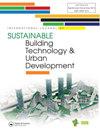Analysis of critical features and evaluation of BIM software: Towards a plug-in for construction waste minimization using big data
Q4 Engineering
International Journal of Sustainable Building Technology and Urban Development
Pub Date : 2015-01-01
DOI:10.1080/2093761X.2015.1116415
引用次数: 67
Abstract
The overall aim of this study is to investigate the potential of Building Information Modelling (BIM) for construction waste minimization. We evaluated the leading BIM design software products and concluded that none of them currently support construction waste minimization. This motivates the development of a plug-in for predicting and minimizing construction waste. After a rigorous literature review and conducting four focused group interviews (FGIs), 12 imperative BIM factors were identified that should be considered for predicting and designing out construction waste. These factors were categorized into four layers, namely the BIM core features layer, the BIM auxiliary features layer, the waste management criteria layer, and the application layer. Further, a process to carry out BIM-enabled building waste analysis (BWA) is proposed. We have also investigated the usage of big data technologies in the context of waste minimization. We highlight that big data technologies are inherently suitable for BIM due to their support of storing and processing large datasets. In particular, the use of graph-based representation, analysis, and visualization can be employed for advancing the state of the art in BIM technology for construction waste minimization.BIM软件关键特性分析与评价:构建基于大数据的建筑垃圾最小化插件
本研究的总体目标是调查建筑信息模型(BIM)在建筑垃圾最小化方面的潜力。我们评估了领先的BIM设计软件产品,得出的结论是,它们目前都不支持建筑垃圾最小化。这促使开发用于预测和最小化建筑垃圾的插件。经过严格的文献回顾和四次焦点小组访谈(FGIs),确定了12个必要的BIM因素,这些因素在预测和设计建筑垃圾时应该考虑。将这些因素分为BIM核心特征层、BIM辅助特征层、废弃物管理标准层和应用层四层。此外,我们亦建议采用bim技术进行建筑废物分析(BWA)。我们还研究了在最小化浪费的背景下使用大数据技术。我们强调,大数据技术天生就适合BIM,因为它们支持存储和处理大型数据集。特别是,使用基于图形的表示,分析和可视化可以用于推进建筑垃圾最小化的BIM技术的最新状态。
本文章由计算机程序翻译,如有差异,请以英文原文为准。
求助全文
约1分钟内获得全文
求助全文
来源期刊

International Journal of Sustainable Building Technology and Urban Development
Engineering-Building and Construction
CiteScore
1.20
自引率
0.00%
发文量
0
期刊介绍:
The International Journal of Sustainable Building Technology and Urban Development is the official publication of the Sustainable Building Research Center and serves as a resource to professionals and academics within the architecture and sustainability community. The International Journal of Sustainable Building Technology and Urban Development aims to support its academic community by disseminating studies on sustainable building technology, focusing on issues related to sustainable approaches in the construction industry to reduce waste and mass consumption, integration of advanced architectural technologies and environmentalism, sustainable building maintenance, life cycle cost (LCC), social issues, education and public policies relating to urban development and architecture .
 求助内容:
求助内容: 应助结果提醒方式:
应助结果提醒方式:


